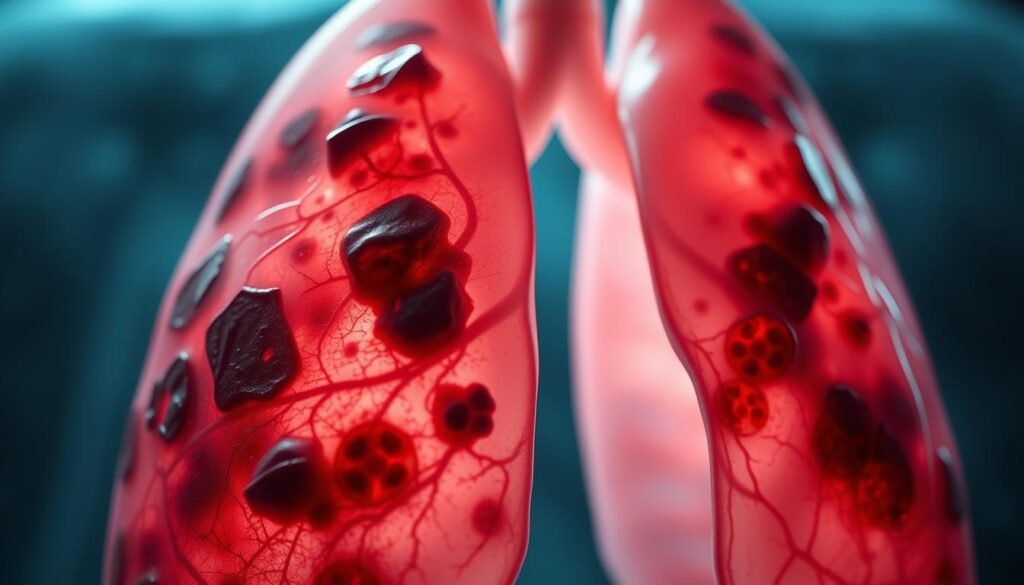Did you know people with untreated non-small cell lung cancer (NSCLC) often live only around 7 months? This fact shows how vital it is to understand lung cancer’s final stages. For those going through this tough time, knowing about lung cancer deeply matters.
As lung cancer gets worse, symptoms and treatment options change. It’s crucial to keep up with the illness’s stages. Facing the last part of life can be hard. Yet, with the right care and support, families can face the challenges that come.
Key Takeaways
- Understanding lung cancer stages of death can help patients and families navigate treatment and care options.
- Awareness of symptoms in late-stage lung cancer is critical for managing end-of-life care.
- Support systems and emotional readiness are essential for families coping with advanced cancer.
- Knowledge about treatments like chemotherapy and immunotherapy can empower treatment decisions.
- Timing and recognition of progression in lung cancer can influence quality of life during end stages.
Introduction to Lung Cancer
Lung cancer is a major health problem worldwide and is the top reason for cancer deaths. This lung cancer introduction is designed to share crucial information. It covers the two main types of lung cancer: non-small cell lung cancer (NSCLC) and small cell lung cancer (SCLC).
Heavy smokers mostly get small cell lung cancer. On the other hand, non-small cell lung cancer is not as common but can often be treated if found early. About 90% of lung cancer in men and 80% in women comes from smoking.
Even secondhand smoke can raise the chance of getting lung cancer for nonsmokers. Being exposed to radon, asbestos, or chromium at work also increases this risk.
Quitting smoking can greatly lower your lung cancer risk. Also, eating plenty of fruits and vegetables and exercising can help.
Knowing the early signs of lung cancer is very important for treatment success. Some signs include a lasting cough, losing weight without trying, and having trouble breathing. For more on early signs, check out this resource.
Understanding Lung Cancer Progression
Lung cancer progression outlines how the disease evolves through stages, impacting treatment and outcomes. Initially, in stage 1, the cancer is confined and might not show symptoms. As it moves to stages 2 and 3, the severity increases, spreading to nearby lymph nodes. Understanding the spread is vital, especially in stage 4, where it can reach distant organs.
In the U.S., lung cancer is the third most common cancer, making up 12.2% of all new cases. Non-small cell lung cancer (NSCLC) represents the majority, with 80-85% of cases. Small cell lung cancer (SCLC) accounts for 10-15%. Survival rates differ greatly across stages. For instance, stage 4 NSCLC patients have a 5-year relative survival rate of only 9%. Meanwhile, it’s around 3% for SCLC.
Age and gender can play roles in lung cancer progression and survival chances. Older patients often have worse outcomes. Women usually live longer after being diagnosed than men. Also, racial differences in healthcare access and coverage lead to higher mortality rates in some communities.
Knowing the stages of lung cancer aids in choosing the best treatment routes. New drug therapies, especially for those with certain genetic mutations like EGFR, are promising. Besides, quitting smoking before starting chemotherapy can prolong life. For more information, click on this detailed article.
Lung Cancer Stages of Death
Knowing about the stages of lung cancer at death helps families dealing with a diagnosis. It’s important to understand stage 4 lung cancer because it means the cancer has spread. This makes treatment harder. In the last stages, patients might face tough symptoms that could lower their quality of life.
Defining Stage 4 Lung Cancer
Stage 4 lung cancer has spread to other body parts, like the liver or brain. This stage offers fewer treatment chances and usually means care focuses on comfort. The survival rate is low, with only a 6% chance of living five more years, says the American Cancer Society.
Recognition of Symptoms in Final Stages
Spotting symptoms in the last stages helps families get ready for what’s coming. Symptoms may include:
- Changes in appetite: Many lose their hunger or thirst.
- Possible changes in secretions: Mucus buildup can make breathing sound strange.
- Circulation and temperature variations: Hands and feet may get cold, and skin could darken.
- Alterations in senses: Vision and hearing might weaken, but touch usually remains.
- Changes in breathing: Breathing could change, with grunting or hard breaths.
- Changes in elimination: Urine may turn dark, and control could be lost.
- Signs of imminent death: Breathing and heart rate might stop, and pupils may not react.
Hospice care is very important for supporting patients and their families during this time. This care helps manage symptoms and provides emotional and spiritual support. Knowing what changes to expect helps families create a caring environment as they navigate lung cancer’s final stages.
| Aspect | Possible Changes |
|---|---|
| Appetite | Loss of desire to eat or drink |
| Secretions | Thick mucus causing rattling sounds |
| Circulation | Cool extremities; darkened skin |
| Senses | Blurred vision; diminished hearing |
| Breathing | Irregular patterns; potential grunting |
| Elimination | Dark urine; possible loss of control |
| Signs of End-Stage | Breath cessation; heart rate loss |
Common Symptoms in Late Stage Lung Cancer
Late stage lung cancer brings several major symptoms that affect the patient’s life. Knowing these symptoms helps caregivers provide better support. This care is vital for the patient’s comfort and life quality.
Shortness of Breath and Fluid Accumulation
Patients often struggle with shortness of breath due to fluid around the lungs. This situation causes much discomfort. It may require medical procedures to remove fluid or prevent its buildup. Treating this symptom is key for helping patients breathe easier and live more normally.
Pain Management Options
Managing pain is key for patients in lung cancer’s final stages. Pain might come from the cancer spreading. Opioids like morphine help reduce this pain, making the patient more comfortable. Working with doctors on pain relief is vital to improve the patient’s well-being.
Significance of Fatigue and Weight Loss
Intense fatigue and significant weight loss are common, known as cancer cachexia. Fatigue affects more than just energy levels; it impacts daily activities and quality time with family. Weight loss leads to weakness and health decline. Supportive care is crucial for these patients.
Terminal Lung Cancer Symptoms
Terminal lung cancer signs signal important changes as a person nears the end of life. It’s crucial to understand these symptoms. This helps caregivers give needed support and comfort to their loved ones. Knowing about end-of-life signs allows for timely help and better care during this hard time.
Critical Indicators Leading to End-of-Life
It’s vital for families and caregivers to know the signs of terminal lung cancer. The key symptoms of the last stages include:
- Severe fatigue
- Persistent cough or coughing up blood
- Significant weight loss and loss of appetite
- Shortness of breath and fluid accumulation around the lungs
- Patient’s confusion or delirium
These signs mean the body is starting to shut down. Getting in touch with a doctor or hospice care can help handle symptoms better. This ensures the patient gets the most caring support possible.
Neurological Symptoms from Brain Metastases
When lung cancer spreads to the brain, it can cause specific symptoms. Patients may face:
- Headaches that persist or worsen
- Seizures without a prior history
- Weakness or numbness in limbs
- Problems with coordination and balance
- Changes in consciousness or focus
Knowing these brain symptoms is essential, as they often show health decline. Caregivers must treat these changes with kindness and get medical advice. This ensures loved ones get the right support and treatment.
| Symptom | Description |
|---|---|
| Severe Fatigue | Extreme tiredness that doesn’t get better with rest; common as the body weakens. |
| Persistent Cough | Constantly coughing, often with blood; shows advanced lung disease. |
| Shortness of Breath | Hard to breathe, can get worse with fluid in lungs; needs quick care. |
| Neurological Changes | Confusion and upset; may mean brain problems from spreading cancer. |
| Weight Loss | Losing weight and appetite without trying; tough for patients and their families. |
Understanding Advanced Lung Cancer Signs
Advanced lung cancer marks a crucial shift in a patient’s health. It often leads to late-stage cancer. Recognizing these signs is vital for those caring for patients. Symptoms include a persistent cough, noticeable weight loss, and significant difficulties in breathing.
As the disease advances, patients face tough challenges. Caregivers can better support emotional and physical needs by understanding these symptoms. Late-stage lung cancer signs, like shortness of breath and fatigue, can cause distress. This shows how crucial good palliative care is.
Table 1 summarizes some of the key advanced lung cancer signs:
| Symptom | Description |
|---|---|
| Persistent Cough | Continual coughing that does not improve over time. |
| Severe Weight Loss | Notable reduction in body weight without an apparent reason. |
| Difficulties in Breathing | Challenges in breathing, especially during regular activities. |
| Loss of Appetite | Decreased interest in food, leading to further weight loss. |
| Fluid Build-up | Fluid accumulation around the lungs, causing additional breathing difficulties. |
These symptoms show how lung cancer progresses. They also show why care needs compassion and understanding. Catching these signs early can greatly help a patient’s life. For managing symptoms, this resource is very helpful. Good care can assist patients through their difficult journey.

End Stages of Lung Cancer
The final period of lung cancer brings not just physical pain but deep emotional shifts too. Patients may feel many things: accepting, giving up, or scared. It’s vital for caregivers to understand and help with these emotional changes during this tough time.
Emotional and Spiritual Changes During Dying
In their last days, people may pull away from family or want to be closer. They often think back on their lives, discussing relationships and the afterlife. These spiritual thoughts help start conversations about beliefs and hopes, bringing comfort to those facing death.
As lung cancer reaches its final stages, patients start to physically decline. This includes:
- Pain management challenges
- Severe fatigue and weight loss
- Shortness of breath and persistent cough
- Neurological symptoms from brain metastases
Family members see these changes, which leads to deeper talks about feelings and spirituality. Knowing the signs of death – like cooler skin or different breathing – helps caregivers give the best care. This understanding builds a supportive space for dying individuals and their families.
Late Stage Lung Cancer Prognosis
Patients and families often worry greatly about late stage lung cancer. The outlook for stage 4 lung cancer is tough. This stage means the disease has advanced far and there aren’t many treatments left.
About 5 out of 100 people with stage 4 lung cancer live for at least five years. This shows how survival rates drop severely at later stages.
Many things can affect a patient’s outlook. If someone has lost more than 5% of their body weight before treatment, their odds aren’t as good. How well someone can do daily activities is also key. Better ability often means a better prognosis.
Certain genes in lung cancer cells can also shape treatment and outcomes. Women with lung cancer usually have a bit better odds than men. This shows why treatments need to be tailored to each person.

Lung Cancer Mortality Stages
Lung cancer, especially in advanced stages, is tough for patients and caregivers. Knowing the stages of lung cancer mortality is key. It helps families know what might happen. Most facing late-stage lung cancer have weeks to months left. This time comes with big changes for them. Families can prepare for the final days by understanding these stages.
Typical Timeframes for Stage 4 Lung Cancer
Stage 4 lung cancer, or metastatic lung cancer, often has a poor outlook. The 2-year survival rate for Stage IVA is 23%. For Stage IVB, it’s much lower at 10%. These numbers help bring some certainty during hard times. As cancer advances, patients might feel more tired and lose weight. Signs like these signal a worsening condition. About 60% survive five years if their lung cancer is found early. But, the outlook changes as the cancer grows. Websites like survival statistics share more about these outcomes.
Final Days: What to Expect
The last days of lung cancer mean big changes in care. People may breathe differently and need more comfort and emotional support. Care focuses on easing pain, showing how crucial comfort is at this time. Knowing this helps give a respectful end, tailored to each person’s needs. Every journey with lung cancer is personal but shares a common thread. It highlights the importance of support during these tough times.
| Stage | 2-Year Survival Rate | 5-Year Survival Rate |
|---|---|---|
| Stage IVA | 23% | 10% |
| Stage IVB | 10% | 0% |
| Localized (NSCLC) | 60% | 60% |
| Regional (SCLC) | 15% | 3% |
Supporting Loved Ones During End-of-Life Care
Supporting a loved one during end-of-life care is tough. It carries an emotional load. Open conversations help caregivers and patients talk openly about their feelings and choices.
Hospice care for lung cancer can greatly help with quality of life. Patients and their families often feel better emotionally and physically with hospice care. Usually, hospice care starts when a doctor thinks a patient has six months or less to live. Talking early about end-of-life care lets patients share what they want and helps them take part in decisions.
Caregivers can get tired both physically and emotionally. It’s important to have support from friends and family. This can lower stress and give caregivers a break. Talking early about what the patient wants ensures their care matches their wishes.
Encouraging patients to talk about good memories can give them emotional support. Talking about life’s big moments and sharing feelings can bring everyone closer together. It’s key for caregivers to talk to kids about their family member’s condition in a kind and truthful way. This helps reassure them about what’s to come.
Feelings like grief, worry, and loneliness often come with the process of dying. Talking to someone trusted or a professional about these feelings can help. Getting support from spiritual leaders or counseling can bring emotional peace in this hard time. It adds meaning and compassion.
| Support Strategies | Description |
|---|---|
| Open Communication | Encouraging honest discussions about fears and wishes regarding end-of-life care. |
| Utilizing Hospice Care | Enabling access to important resources, improving quality of life and support for families. |
| Seeking Support | Encouraging caregivers to reach out to friends and family to share responsibilities and reduce stress. |
| Emotional Reflection | Providing opportunities to reminisce about meaningful experiences, fostering connection and comfort. |
| Addressing Grief and Loneliness | Promoting engagement in social activities and professional counseling to counter isolation. |

Conclusion
Learning about the final stages of lung cancer is key for those facing this battle. It’s more than just treatment; it’s about understanding what the journey involves. Knowing the signs and what to expect helps families prepare better.
Talking about end-of-life care is crucial. It helps to discuss preferences with loved ones and doctors. This ensures everyone’s wishes are respected, creating a supportive atmosphere. There are resources to help understand the effects of lung cancer, like this resource.
Understanding these stages brings families closer, offering emotional and spiritual support. It focuses on comfort and quality of life, respecting each person’s choices. Recognizing early signs of lung cancer is also important for better outcomes, learn more here. This knowledge gives peace and power to those affected by lung cancer.